Vintage Guitars Info's
Dobro Metal Body Resonator
Vintage Guitar Info.
Private vintage guitar collector. Pictures, history for Dobro metal body resonator vintage guitars from 1935 to 1940.
Dobro picture gallery
Contact the Vintage Guitar Info Guy
1938 Dobro No.35 metalbody

-
Introduction:
- Dobro Vintage Resonator Introduction
- 1928-1937 Vintage Dobro Serial Numbers (includes both metal and wood body resonator instruments)
- 1970-present OMI Dobro Serial Numbers (includes both metal and wood body resonator instruments)
- M-32 gold painted vintage resonator metalbody
- M-35 sunburst painted vintage resonator metalbody
- M-46 "Lumalite" silver painted vintage resonator metalbody
- M-47 "Lumalite" mahogany grain painted vintage resonator metalbody
- M-14 nickel plated vintage resonator metalbody
- M-15 nickel plated vintage engraved resonator metalbody
- M-16 nickel plated vintage engraved resonator metalbody
- M-62 "Spanish dancer" nickel plated vintage resonator metalbody
- M-65 "singing ladies" nickel plated vintage resonator metalbody
- Ukulele vintage resonators
1935 to 1940 Metal Body Resonator Vintage Model Info:
Painted Metal body Dobro Resonators:
Nickel Plated Metal body Dobro Resonators:
Introduction:
-
The Resonator.
The Dobro is a single cone resonator guitar that is easily confused at first glace with the single cone National guitars. But in fact, they are fundamentally different in construction and design. The Dobro resonator is dish-shaped, opposite of the volcano-shaped National resonator. The Dobro has an eight legged bridge support (called a "spider") that spans the dish and conducts the string vibrations (compared to National's biscuit system).
If it has a smooth edge, it's a reissue made from 1970 or newer.
Left:1935-1940 No.32 with a gold "frosted Duco" krinkle finish. Note the fiddle edge.
Right:1935-1940 No.62 Dobro with a fiddle edge.
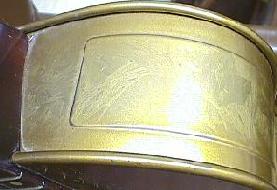

-
Metal Body Resonator Guitars.
Most Dobros have wooden bodies, but Dobro also made metalbody guitars from 1935 to 1940 only. Regal (which was Dobro's exclusive licensee) also made metal body resonator guitars with their brand name and also the "Old Kraftman" name. Several other resonator brand names were also used such as Ward, but these are in fact still Regal/Dobro made resonator guitars. All metalbody Regal/Dobros have 14 frets clear of the body.
The construction of the Regal/Dobro metalbody was quite different than National guitars. Regal/Dobro tops and backs were fastened to the sides with a unique method that required no soldering. The resulting lip around the edges gave rise to the name "Violin Edge" or, "Fiddle Edge" as it was known around the factory. This construction method was only used from 1935 to 1940. All later model metal Dobro's which were in production from the 1970 to the present are easily identifiable because they lack this fiddle edge. Some of these models used a "M-" prefix or "M" suffix around the model number. Hawaiian square neck models used a "P-" prefix or "H" suffix.
Port holes versus f-holes on two metal body vintage 1935-1940 Dobro guitars.
Left: gold "frosted Duco" No.32 with port holes.
Right: sunburst No.35 with f-holes.
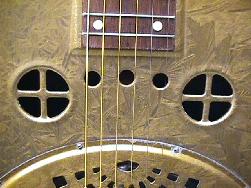
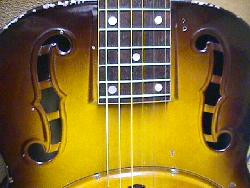
-
Port holes versus f-holes.
Also most Dobro metalbodies have window-like round soundholes in the upper body, except for (consistently) the No.35 which has segmented F-holes. Though some other models will also have segmented F-holes, most models with the Dobro brand name have the round window soundholes. Segmented F-holes are seen more on Regal brand resonator instruments than Dobro.
Metal or wood body, Dobros with "f" holes are considered less desirable than "port" hole models. Dobro used f-holes on their less expensive models, and port holes on their mid to upper end models. This especially applies to wood body Dobros. Metal body dobros this is not really an issue.
The tailpiece used on all 1935-1940 vintage
Dobro metal bodies.
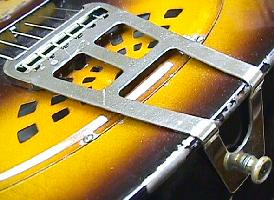
-
Metalbody Dobro Tailpieces.
The tailpiece used on 1935-1940 metal body vintage Dobro's is very unique. And it's very fragile. Often you see these broken where they wrap around the fiddle edge of the body. Since no one has made a fiddle-end guitar since 1940, replacements are very difficult to find.
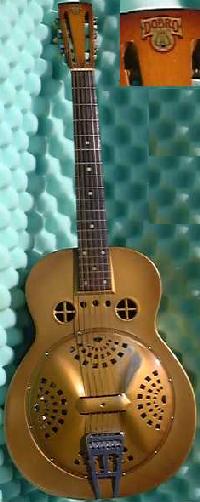

Round versus Square Neck Models.
Roundneck metalbody vintage Regal/Dobros are more valuable than squareneck
metalbodies. In woodbody Dobros, the opposite is true; squareneck woodbody
Dobros are more valuable than roundneck woodbodies.
I collect just roundneck metalbody Regal/Dobros. They have a sweet tone with limited attack, but long decay (opposed to National's single cone sound of sharp attack, short decay). In this respect, a good metalbody Regal/Dobro sounds a lot like a tricone National.
Lucky for me, metalbody Regal/Dobros are not considered by the collector community to be as good or valuable as National metalbody guitars. This has kept the prices somewhat low compared to other vintage guitars.
Back to the Table of Contents
A Dobro peghead decals from the 1930's. The "solid" peghead on
the right is from a (1938-1940) M-35 metal body.
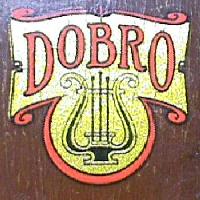

Serial number on a 1936
M-35 metal body.
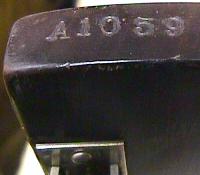
Dobro Serial Numbers
1929 to 1937 Dobro Serial numbers
by M.Cass. Note the 1929 to 1937 serial number info is not very accurate. For
example I own a Dobro metal body M-62 with the serial number 1832.
According to the list below it should be 1930. But no metal body
Dobro existed before 1935. So you can see the serial number info
below is not 100% reliable and the
information below applies mostly to wooden body resonator Dobro guitars.
Pleaes keep this in mind. Also I don't have any 1937 to 1942 Dobro
serial number info. Serial numbers for metal body Dobros very scarce.
Serial numbers are stamped into the top of the peghead. No factory serial
number records are available. The numbers below are a general guide,
and are not reliable for dating the instrument solely on the serial number.
Number range Year 800 - 1400 1929 1400 - 2000 1930 2000 - 2600 1931 2600 - 3200 1932 3200 - 3900 1933 4000s 1933 (mostly Regal made) 5000 - 5600 1933 (California made) 5700 - 7600 1934-1936 (California made) 8000 - 9900 1936 & 1937 L9000s 1937 (Regal made) A prefix 1936 B prefix or suffix 1931-1932 (most Cyclops wood models) M prefix 1935-1937No serial number: on 1930s Dobros, this happens a lot, and for no explainable reason.
OMI Dobro Resonator Serial Number.
The Dopyera brothers started the OMI company making Dobro style guitars in 1967
under the "Hound Dog" brand name. In 1970
OMI bought the Dobro name and manufacturered their own "Dobro" guitars
with the traditional "Dobro" peghead sticker. These 1967 and later Dobros not collectible.
In 1998 Gibson bought Dobro.
1967-1974 OMI Dobro: 101 - 401 1967-1970 402 - 712 1971 713 - 1427 1972 1428 - 2296 1973 2297 - 2372 early 1974 1974-1979 OMI Dobro: Y (#)### D configuration. Y is last digit of the year (if this number is "3" it is actually 1974). 3 or 4 numerals in center are instrument ranking for year starting with 101. D is body type: D=wood, B=brass, M=steel or mandolin. 1980-1988 OMI Dobro: 8 (#)### yD configuration. 8 is the decade of manufacture (8=1980s). 2 or 3 or 4 numerals in center are serial number for year. Numeral y before letter is last digit of year. Last character is body type: D=wood, B=metal. 1988-1994 OMI Dobro: A# #### yyD configuration. First letter (and numeral) is style. numerals in center are instrument ranking. yy is last two digits of year. Last character is body type: D=wood, B=metal, H=Hounddog, P=solid peghead. 1995-1997 OMI Dobro: A(A) (x)xxx yy configuration. First letters are style. numerals in center are instrument ranking. yy is last two digits of year year. 1998-current Gibson Dobro: 8 digits ymmddrry configuration First y is last digit of year. mm is month dd is day rr is rank last y is decade.The hardshell case sold with many 1935
to 1940 metal body Dobros (and Nationals!).
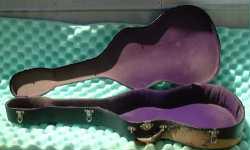
Back to the Table of Contents
Regal/Dobro Metal Body Resonator Vintage Guitars.
Painted Dobro Fiddle Edge Metal Resonators.
Some of these models used a "M-" prefix or "M" suffix around the model number. Hawaiian
square neck models used a "P-" prefix or "H" suffix.
-
No.32 or M-32
Sheet metal steel body, smooth gold metallic finish or a gold krinkle "Frosted Duco" painted finish, usually round window soundholes (but sometimes segmented "f" holes), dot fingerboard inlays, unbound rosewood fingerboard, 14 frets clear of the body, painted resonator plate, peghead with "Dobro" peghead decal. Retail price of $32.50, available 1935 to 1940. The most common model.
No.35 or M-35
Sheet metal steel body, walnut sunburst (yellow or orange fades to brown) painted finish,
usually segmented "f" holes (but sometimes round window soundholes),
dot fingerboard inlays, bound rosewood fingerboard (sometimes unbound), 14 frets clear
of the body, painted resonator plate, gold sparkle peghead overlay with "Dobro" peghead decal.
Retail price of $35, a slightly fancier and expensive version of the
M-32. The second most common model, appeared in catalogs in 1938 (but may have
been available a year earlier), and hence should always have a pickguard
(or at least two holes in the body where a pickguard was mounted). Discontinued in 1940.
No.46 or M-46
Aluminum metal body (known as the "Dobro-Lite" or "Lumalite"), silver painted finish with gold
highlights, dot fingerboard inlays, unbound rosewood
fingerboard, 14 frets clear of the body, round window soundholes, painted resonator plate,
peghead with "Dobro" decal. Retail price of $45, available 1935 to 1940.
The aluminum body makes for minimal midrange and practically no bass. Also this models
have a serious problem with paint adhesion (paint just doesn't stick well to
aluminum). The worst sounding
Dobro fiddle edge, but sold (correctly) as being "light as a feather".
No.47 or M-47
Aluminum metal body (known as the "Dobro-Lite" or "Lumalite"),
mahogany grain painted sunburst finish, dot fingerboard inlays, unbound rosewood
fingerboard, 14 frets clear of the body, round window soundholes, painted resonator plate,
peghead with "Dobro" decal. Retail price of $47.50,
slightly fancier and expensive version of the M-46. Appeared in catalogs
in 1938 (but may have been available a year earlier), and hence should always have a pickguard
(or at least two holes in the body where a pickguard was mounted). Discontinued in 1940. The aluminum body makes
for minimal midrange and practically no bass. Also this models
have a serious problem with paint adhesion (paint just doesn't stick well to
aluminum). The worst sounding Dobro fiddle edge,
but sold (correctly) as being "light as a feather".
Right: Dobro No.62 "Spanish Dancer"
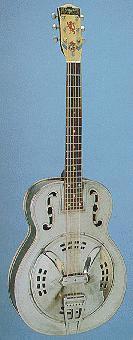
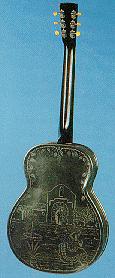
Silver Dobro Fiddle Edge Metal Resonators.
Some of these models used a "M-" prefix or "M" suffix around the model number. Hawaiian
square neck models used a "P-" prefix or "H" suffix. The No.14, No.15 and No.16 are
mentioned in catalogs with different model numbering styles (hence the multiple
name variations).
-
No.14 or M-14 "Leader Model". Also known as the M-14, 14M (Spanish), M-14H, P-14 (Hawaiian).
Nickel plated brass body with no engraving (or sometimes a border engraving around the outside body edge), dot fingerboard inlays, rosewood fingerboard (usually unbound), mahogany neck, round window soundholes, peghead with "Dobro" decal or pearl "Dobro" crest. Retail price of $67.50, available 1935 to 1940. A nice attractive model, but looks better than it sounds because of the brass body.
No.15 or M-15 "Professional Model". Also known as the M-15, 15M (Spanish), M-15H, P-15 (Hawaiian).
Nickel plated German silver body with small engraved "Dobro" crest on back and
engraving on sides, dot fingerboard inlays, bound rosewood fingerboard,
mahogany neck, round window soundholes, peghead with pearl "Dobro" crest.
Retail price of $95, available 1935 to 1940.
A nice attractive model, looks great and sounds better than its brass bodied M-14 cousin.
No.16 or M-16 "Artist Model". Also known as the M-16, 16M (Spanish), M-16H, P-16 (Hawaiian).
Nickel plated German silver body, highly engraved with large "Dobro" crest on back
and engraving on sides, dot fingerboard inlays, bound ebony fingerboard,
mahogany neck, round window soundholes, peghead with pearl "Dobro" crest.
Retail price of $135, available 1935 to 1940.
A nice attractive model with a good sound.
No.62 or M-62
Nickel plate brass metal body (like a National Style O), "Spanish dancer" scene sandblasted
into the nickel finish, dot fingerboard inlays, bound rosewood fingerboard,
round window sound holes, "DOBRO" inlaid with celluloid into the
rosewood peghead veneer. Retail price of $62.50, available 1935 to 1940.
An amazing looking model. More show than go because of the brass body.
No.65 or M-65
Similar to the No.62 model, but with slightly different sandblasted
pattern. Nickel plate brass metal body (like a National Style O), "singing ladies" scene
sandblasted into the nickel finish, dot fingerboard inlays, bound rosewood fingerboard,
round window soundholes, "DOBRO" inlaid with celluloid into the
rosewood peghead veneer. Retail price of $65. Appeared in catalogs
in 1938 (but may have been available a year earlier), and hence should always have a pickguard
(or at least two holes in the body where a pickguard was mounted). Discontinued in 1940. An amazing looking model.
More show than go because of the brass body.
1930's Dobro Uke

-
Dobro Vintage Resonator Ukuleles.
Dobro made ukuleles also. I don't have any information on them, but if you have one please e-mail me.
Back to the Table of Contents
Copyright 1995-2005 all rights reserved.